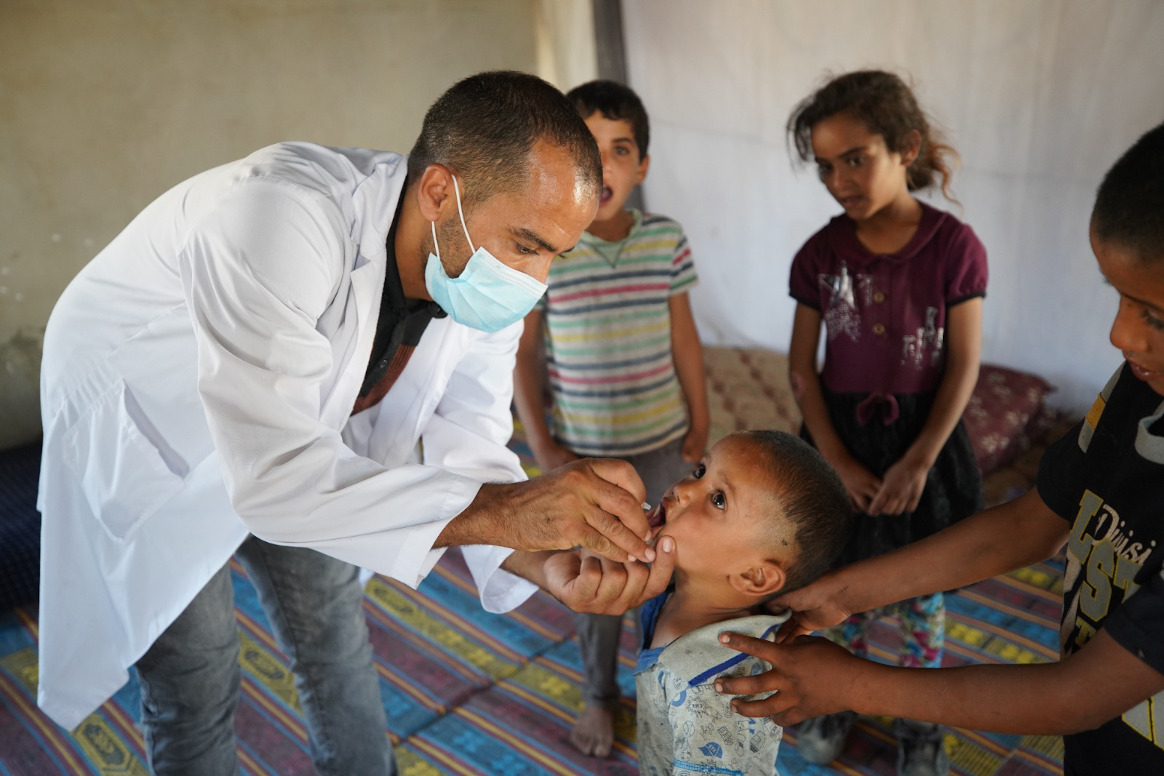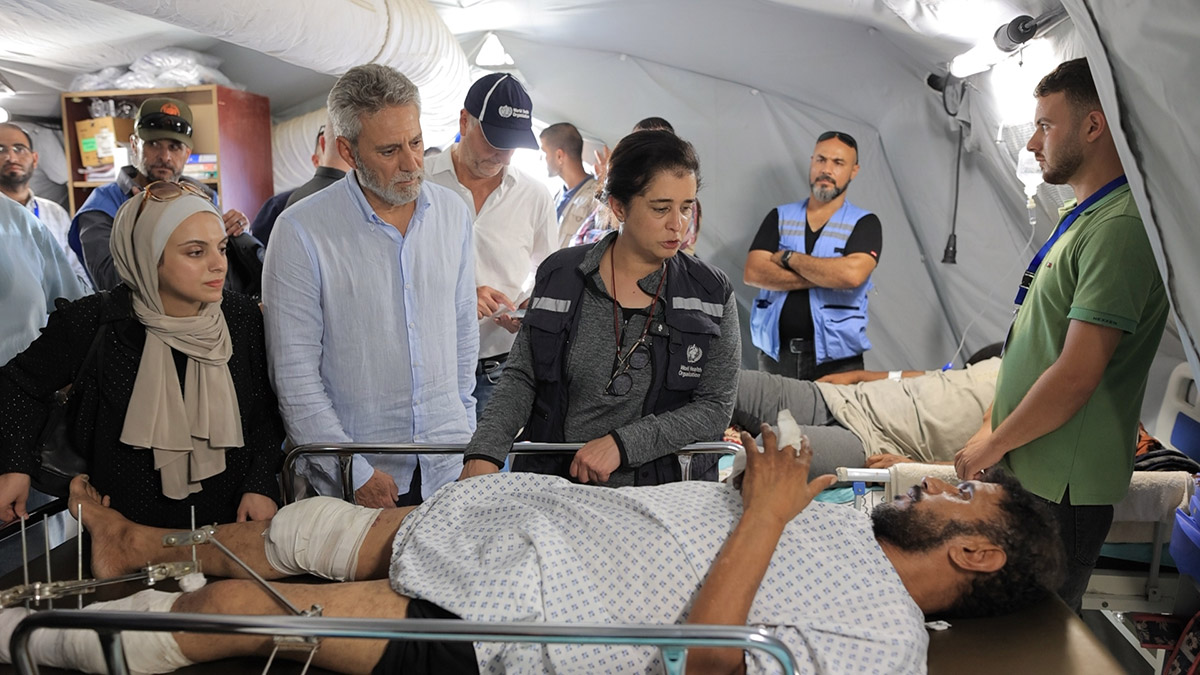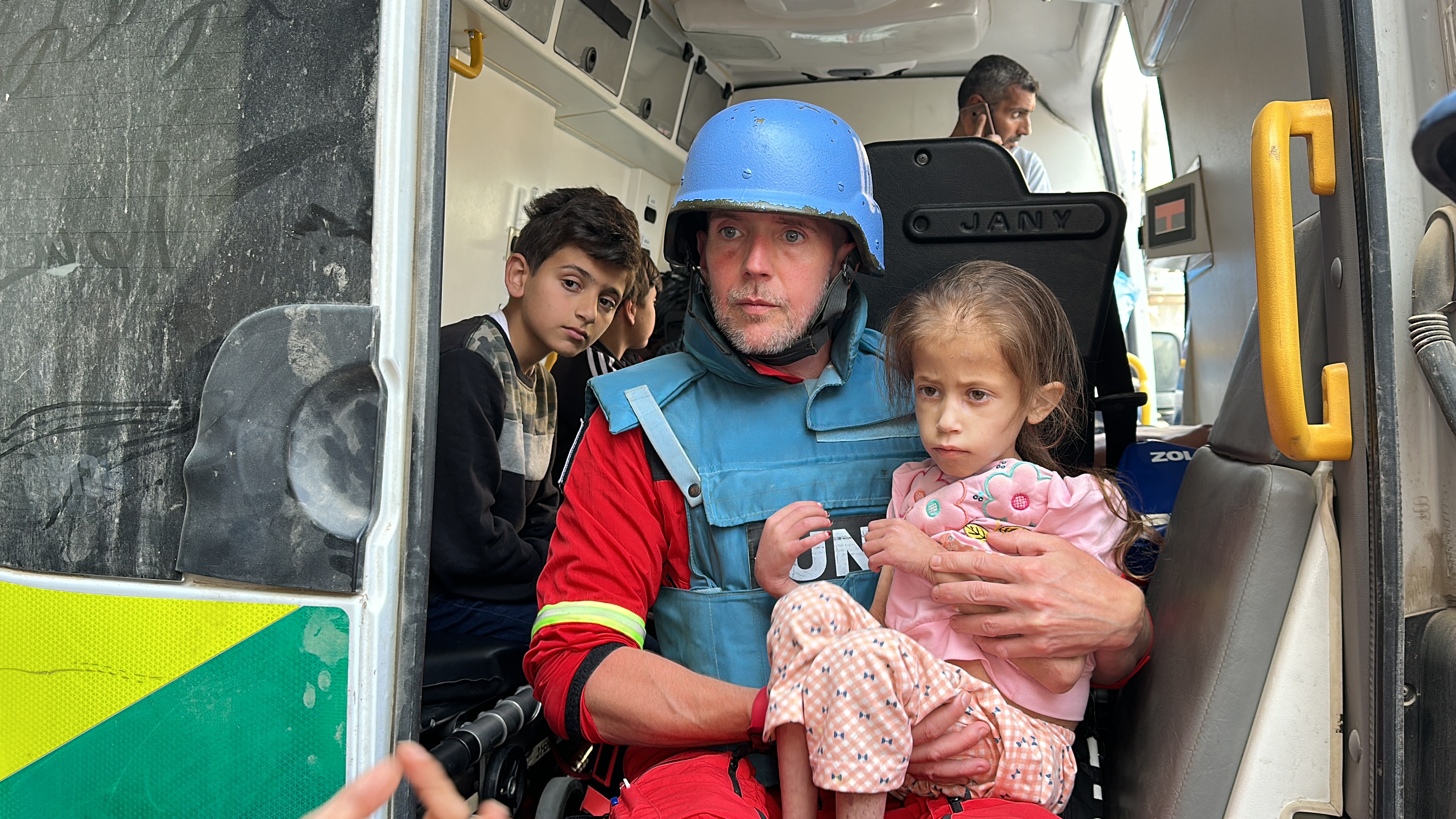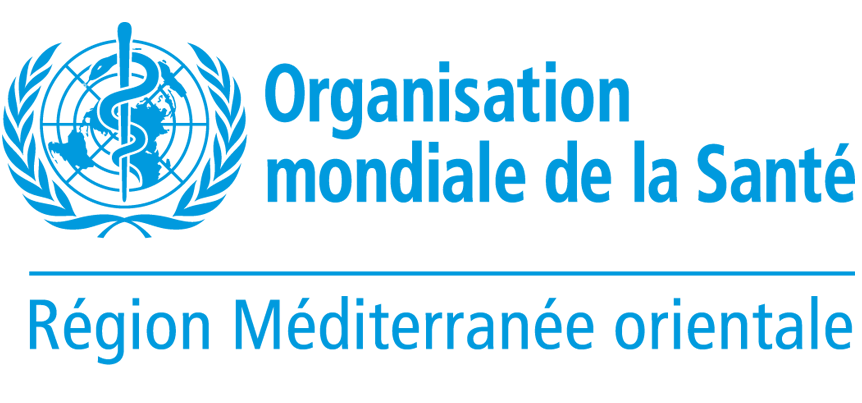Variant type 2 poliovirus isolated from sewage samples in Gaza

Circulating variant type 2 poliovirus (cVDPV) has been confirmed in the Gaza Strip. Virus was isolated from six environmental (sewage) samples, collected from two different collection sites in two sub-regions within Gaza, collected on 23 June 2024.
The variant poliovirus strains detected in six wastewater samples, collected from two environmental surveillance sites in Khan Younis and Deir al Balah. Further genomic sequencing of poliovirus isolates has identified that these strains have close genetic links with each other and are also closely related to the poliovirus variant that was circulating in Egypt during the second half of 2023. The last detection of the related variant polioviruses in Egypt was in samples collected in December 2023. Based on the analysis of genetic changes in the isolates, the variant poliovirus could have been introduced in Gaza as early as September 2023. It is important to note that virus has been isolated from the environment only at this time; no associated paralytic cases have been detected.
A risk assessment is being implemented, led by the Ministry of Health, including to assess surveillance sensitivity for the detection of acute flaccid paralysis (AFP) and environmental surveillance, and subnational immunity levels are being more clearly assessed.
WHO, UNICEF and UNRWA continue to work with all public health authorities on the ground, as part of urgent efforts to mitigate the impact of the current crisis on the health of populations in Gaza. The ongoing crisis continues to pose a significant challenge to the ability to implement full disease surveillance and outreach with immunization services.
Routine immunization rates in the occupied Palestinian territory (oPt) were optimal before the start of conflict in October 2023. Polio vaccination coverage (POL3), primarily conducted through routine immunization, was estimated at 99% in 2022. This has declined to 89% in 2023, according to the latest WHO-UNICEF routine immunization estimates (WUENIC).
Currently, only 16 out of 36 hospitals are partially functional and 45 out of 105 primary health care facilities are operational. The impact on health system, insecurity, inaccessibility, population displacement, and shortages of medical supplies, coupled with poor quality of water and weakened sanitation, have contributed to reduced routine immunization rates and an increased risk of vaccine-preventable diseases, including polio.
WHO considers there to be a high risk of spread of this strain within Gaza, and internationally, particularly given the impact the current situation continues to have on public health services.
This statement was published on 19 July and was updated with additional information on 21 July.
Statement by WHO Regional Director Dr Hanan Balkhy on visit to the occupied Palestinian territory

11 July 2024, Cairo, Egypt -- I have just returned from the occupied Palestinian territory, where I visited the West Bank, including East Jerusalem, Jenin, and Gaza.
The situation in Gaza is concerning on both a human and humanitarian level. I saw firsthand the scale of devastation: lives and homes in ruins, hospitals overwhelmed, and a fully destroyed city.
Lack of fuel is compromising all health and humanitarian operations.
Running sewage and garbage litter demolished streets, with the smell of fermented waste permeating the air. This situation is providing the perfect breeding ground for diseases to spread, leading to an increase in cases of acute watery diarrhea and acute respiratory infections.
Ongoing violence and the breakdown of law and order are devastating an already crippled city and creating an extremely high-risk environment, not just for aid workers but everyone in Gaza.
The breakdown of law and order also makes it nearly impossible to manage gender-based violence, exposing displaced Palestinians to additional life-threatening risks.
I met with WHO staff in Gaza, many of whom are national staff who have faced personal loss and suffering. Despite these challenges, they continue to risk their lives to deliver fuel and medical supplies to hospitals, and transfer patients to safety and care, striving to overcome delays and obstructions along the way.
As a result of increasing hostilities and soaring needs, WHO has expanded its medical supply chain for Gaza. However, much of this aid remains stuck on the wrong side of the borders, with only a fraction reaching Gaza.
And even when supplies do enter Gaza, the breakdown of law and order again makes it challenging for our teams to deliver them to hospitals that urgently need them.
I visited the IMC field hospital in Deir Balah, which has relocated twice and tripled its capacity over the past few months. There, I met severely malnourished 7 year old Jana, who was evacuated from Kamal Adwan in the north three months ago, and is still waiting for evacuation outside Gaza.
Jana is one of more than 10,000 patients in need of specialized care outside the Strip, yet who remain unable to exit since 7 May. Their conditions range from trauma injuries to chronic diseases, to others.
In my meetings with Muhannad Hadi, UN Deputy Special Coordinator and Resident Humanitarian Coordinator for the occupied Palestinian territory, and Tor Wennesland, the UN Special Coordinator for the Middle East Peace Process, we agreed on the need for immediate action to address suffering in Gaza.
We need Member States to swiftly fulfill their global diplomacy mandate and expedite an immediate truce.
We need all borders, including the Rafah border, to open and allow fuel, medical supplies, and other essential humanitarian aid to flow in.
And we need those who require medical care to be able to exit.
Before October 7, despite the need for permits, Gazans were able to seek medical care in the West Bank, including East Jerusalem. This access to care must be restored. And those who need medical care in other countries must also be allowed to exit without further delay.
Gazans need more than just food, water, and medicine—they need protection, peace, security, and dignity. One man told me, "We long for a ceasefire, for a chance to live without fear."
A woman told me that she has one question for the world to answer. "Do you consider us human?" she asked me three times.
During my 11-day visit, I travelled to the West Bank, where I saw a rapidly worsening health situation. At Jenin General Hospital and the UNRWA clinic, I learned about health workers killed or injured due to repeated attacks and saw extensive damage to infrastructure and medical equipment.
With damaged roads and restricted access, WHO and partners, including the Palestinian Red Crescent Society, have set up mobile medical services to reach people at the point of injury.
At Jenin General Hospital and six other West Bank hospitals, WHO has supported mass casualty management training and response planning. Our goal is seamless and effective trauma care across all levels, based on lessons from Gaza.
As we support the right to health for all Palestinians, we must also work to strengthen already fragile health systems in neighboring countries, including Jordan, Lebanon, and Syria.
We are extremely concerned about the escalation of violence along the border between Lebanon and Israel, resulting in increased deaths and injuries among civilians and health workers, displacement, and damages to health infrastructure.
In our Region, entire generations have grown up knowing nothing but conflict and deprivation. Addressing the root, political causes of these emergencies is not just a humanitarian necessity but a strategic investment in Regional stability and security.
 WHO Regional Director Dr Hanan Balkhy along with Mr Muhannad Hadi, UN Deputy coordinator and resident Humanitarian Coordinator visit the International Medical Corps (IMC) field hospital in Gaza
WHO Regional Director Dr Hanan Balkhy along with Mr Muhannad Hadi, UN Deputy coordinator and resident Humanitarian Coordinator visit the International Medical Corps (IMC) field hospital in Gaza Regional Director Dr Hanan Balkhy along with Mr Muhannad Hadi, UN Deputy coordinator and resident Humanitarian Coordinator visit the International Medical Corps (IMC) field hospital in Gaza
Regional Director Dr Hanan Balkhy along with Mr Muhannad Hadi, UN Deputy coordinator and resident Humanitarian Coordinator visit the International Medical Corps (IMC) field hospital in Gaza Regional Director, Dr Hanan Balkhy at Al Makassed Hospital, the largest of 6 main referral hospitals in East Jerusalem
Regional Director, Dr Hanan Balkhy at Al Makassed Hospital, the largest of 6 main referral hospitals in East Jerusalem Regional Director Dr Hanan Balkhy visits the Palestinian National Rehabilitation center
Regional Director Dr Hanan Balkhy visits the Palestinian National Rehabilitation centerWHO concerned about escalating health crisis in West Bank
14 June 2024 - WHO remains concerned about the escalating health crisis in the occupied Palestinian territory, including the West Bank, where attacks on health infrastructure and increased restrictions on movement are obstructing access to health care.
A spike in violence in the West Bank, including East Jerusalem, since the war in Gaza started has resulted in the deaths of 521 Palestinians, including 126 children between 7 October 2023 and 10 June 2024. In addition, over 5200 people, 800 of them children, have been injured, adding to the growing burden of trauma and emergency care at already strained health facilities.
As of 28 May, WHO has documented 480 attacks on health care in the West Bank since 7 October 2023, resulting in 16 deaths and 95 injuries. The attacks affected 54 health facilities, 20 mobile clinics and 319 ambulances. Fifty-nine percent of the attacks occurred in the cities of Tulkarem, Jenin and Nablus. They include attacks on health infrastructure and ambulances, detention of health workers and patients, obstruction of their access to health facilities, use of force on health workers and militarized searches of ambulances and staff.
The closure of checkpoints, arbitrary obstructions, and detentions of health workers, rising insecurity, as well as the siege and closure of entire towns and communities has made movement within the West Bank increasingly restricted, impeding access to health facilities. Extensive infrastructure and housing damage, particularly in the northern West Bank, have compounded the situation by obstructing access for ambulances and first-aid responders.
The long-standing fiscal crisis faced by the Palestinian Authority (PA) is further impacting the health system and has been worsened by Israel’s increased withholding of tax revenues meant for the occupied Palestinian territory since 7 October, and the overall deterioration of the economic situation in occupied Palestinian territory. The impact of the financial situation on health service delivery is significant – with health workers receiving only half of their salary for nearly a year and 45% of essential medications being out of stock. In most areas of the West Bank, primary care clinics and outpatient specialty clinics are now operating two days per week, and hospitals are operating at approximately 70% capacity.
Between October 2023 and May 2024, 44% of 28 292 applications for patients to seek medical care outside the West Bank, in East Jerusalem or Israeli health facilities, have been denied or remain pending with access being mainly granted to cancer, dialysis and other lifesaving cases. In the same period, 48% of the 26 562 companion permit applications have been denied or remain pending.
A comparison between October 2022–May 2023 and October 2023–May 2024 shows a 56% decrease in the West Bank patient permit applications and 22% decrease in approvals, and a 63% decrease in companion permit applications and a 24% decrease in approvals. Prior to October 2023, over 300 patients required permits daily to cross from the West Bank to east Jerusalem and Israeli health facilities.
WHO is supporting the Ministry of Health with procurement of essential medications as well as with technical assistance to address some of the policies and procedures that contribute to the fiscal crisis in health. Additionally, WHO has pre-positioned supplies at key hospitals across the West Bank, including in East Jerusalem, and conducted community trauma management training for first aid responders in the affected communities to boost emergency preparedness, but worsening insecurity and accessibility for emergency health workers and field volunteers to reach the injured, combined with the ongoing strict curfews, pose significant risks to the health system and make it very difficult for responders to reach those in need of urgent care.
WHO calls for the immediate and active protection of civilians and health care in the West Bank. International humanitarian law must be respected, which means the sanctity of health care must be observed at all times.
‘I am terrified of losing my daughter’

‘I am terrified of losing my daughter’
As people of Gaza face catastrophic hunger, WHO, with support from European Union, is ensuring that nutrition stabilization centers are equipped to treat cases of severe acute malnutrition.
GAZA, OCCUPIED PALESTINIAN TERRITORY, 19 APRIL 2024 -“My daughter is my life; she was like a flower. Now I can see her ribs and her spine. She can’t even sit, I have to carry her to the toilet,” says Nesma Ayyad, mother of seven-year-old Jana.
Nesma has been alone in Gaza since the war began in October. Her husband had left the Strip for medical treatment and was unable to return home as borders closed and the conflict worsened. With their family home destroyed during a bombing, she has struggled to provide for her four children and keep them safe.
Jana, whom she describes as an active young girl full of life, began suffering from stomach aches, diarrhea, and weight loss due to dire shortages of food and safe water. By February, her condition had deteriorated to the point where she was admitted to Kamal Adwan Hospital in north Gaza due to complications arising from dehydration and severe acute malnutrition.
"The doctor told me she needs nutritious food that I could not provide. I am terrified of losing my Jana,” says Nesma.
Jana’s story is tragically all too familiar. With famine looming, more than half of all Palestinians in Gaza – 1.1 million people – and are facing catastrophic hunger. Twenty-eight patients have reportedly died due to malnutrition, and many are fighting for their life.
Since the onset of hostilities, agricultural and agrifood production in Gaza has collapsed. Currently, about 81% of Gaza households lack access to clean and safe water, with internally displaced persons among the most affected.
Gaza has been reduced to rubble and urgently requires the revival of its local food production to help prevent famine and malnutrition – and this needs the entry of food production and agricultural inputs. With traditional food sources disrupted, humanitarian assistance has become the primary means of survival. To address the population's dire needs, an immediate humanitarian ceasefire, opening of all border crossings, and sustained aid access are crucial, along with the availability of basic goods from the private sector.
WHO, together with its partners, is racing against time to save lives.
Three WHO-supported nutrition stabilization centers are currently operational in hospitals and medical centers in Gaza - two in the south and one in the north of the Strip. With crucial support from the European Union, WHO has supplied these centers with medical supplies for the treatment of up to 1250 children with severe acute malnutrition. Additionally, WHO has trained health workers to identify and treat malnutrition with complications.
Jana’s condition is still critical. After receiving initial treatment at the nutrition stabilization center at Kamal Adwan, she has been transferred by WHO with assistance from CADUS, an international emergency team, to a field hospital in Rafah. She is currently awaiting approval for medical evacuation outside Gaza to continue her treatment.
"I am truly happy that she’s finally going to be able to receive treatment abroad. I hope that day comes soon, says Nesma. “I hope my child comes back healthy as she was before.”








